First an apology that this issue is late. Personal circumstances prevented its timely publication and with the agreement of the Committee this issue will be a combined July / August issue and normal service will resume at the beginning of September.
Members will be sad to hear of the death in May of Allan Canham, aged 91. Allan was a lecturer at Reading University for many years and is best known for his pioneering work on the use of electricity and lighting in horticulture. He authored several key books on the topic including 'Electricity in Horticulture' and 'Artifical Light' in Horticulture.
On 16 June we joined the Professional Horticulture Group South West (PHGSW) for a visit to Kilver Court; an interesting well maintained garden slightly marred by a cage to retain some pointless flamingoes but greatly enhanced by the backdrop of the old stone built factory buildings and an impressive railway viaduct. We then moved on to visit Wraxall Wines of which more below.
On 29 June a small group assembled for an informal tour of the Chelsea Physic Garden in London. Finally on 13 July we again joined PHGSW for a visit to Compton Acres to check on the gardens that Peter Thoday had described in his November talk to the group (see December Newsletter).
Peter Grimbly
From Brambles to Fine Wine
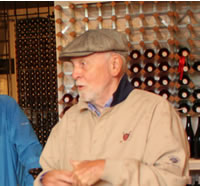
Originally started in 1974, this vineyard had won the South West Vineyard of the year award in the 1980s but then fallen into disrepair and most of the vines had disappeared under twelve foot brambles providing a home for deer, foxes and rabbits. All that remained were some Madeleine Angevine vines which, with expert advice, were salvaged and are still there today. The brambles and all beneath have since been removed and the vineyard replanted.
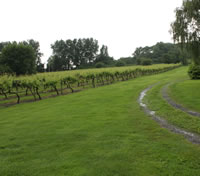
At that time in 2007 the EU had provided money to help the UK wine industry upgrade its skills. As a result there were seminars running almost daily to help the new breed of vineyard owners, mostly people who had made money in the City, learn the trade of wine production but not marketing.

In common with most small vineyards they do not produce their own wine. The grapes are sent ‘over the hill’ to nearby Oatley Wines which specialises in wine making. Brian explained that this is the nature of the modern British wine industry. When wine making first restarted in the UK there was little expertise around and vineyards made their own wines; frequently of dubious quality. Today the industry is focussed around a small number of specialist wine producers who make the wine for the vineyards. Larger vineyards will often have their own winemaker, often from California or another new world wine region, while smaller vineyards send their grapes to these specialists leaving them to concentrate on growing the vines and marketing the end product.
Wraxall Wines now sells six wines, four still and two sparkling. Up to the present they have had to sell all of each year’s bottling in order to maintain their cash-flow. However, they are now reaching the stage where a proportion can be held back for sale in later years as vintage wine. They aim to sell as much as possible direct and have managed to build up a ‘fan club’ of around 600 people who buy regularly.
Needless to say, our visit ended with a tasting and, judging by the number of bottles that subsequently left the cellar the wines proved popular.
Peter Grimbly
Plant of the Month
Delphinium and Consolida, larkspur, Ranunculaceae
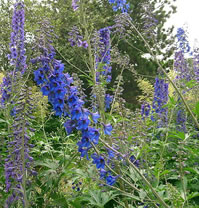
There are over 320 species of Delphinium coming from northern temperate areas through to the tropical African mountains.
The delphiniums familiar to gardeners as stately herbaceous perennials for the backs of borders have a complex background but most include parentage from either or both Delphinium elatum (upper picture by Hanson59) and D. grandiflorum (lower picture by Sydenham Edwards).
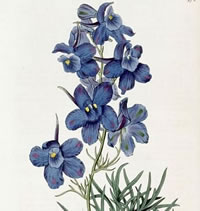
Although there are a wide range of flower colours across the genus – from white and yellow through red to violet and blue, the flower colour that most people associate with these stately plants would arguably be an intense blue. The colours in the flower petals are due to anthocyanin pigments, with different species and cultivars having different constituents in varying amounts.
Anthocyanins that have been found to be present in these plants include cyanodelphin, delphinidin, violdelphin, and pelargonidin type anthocyanins.
One breeder responsible for introducing many new Delphinium cultivars into the trade is the specialist nursery of Blackmore and Langdons. This nursery was started by two men with a passion for Begonias and Delphiniums. James Barret Blackmore and Charles Frederick Langdon were both born in Newton St Loe, but in 1854 and 1868 respectively. They first met at the Bath flower show when both were exhibiting Begonias. The nursery has attended every single Chelsea Flower Show since its inauguration in 1913 and have won over 80 gold medals. They first exhibited at the precursor shows to Chelsea.
However, in addition to being beautiful, like so many other plants, this genus contains many powerfully toxic chemicals. Delphinium species are reported to be the single-largest poisonous plant threat to cattle grazing on open rangelands in the western United States. A group of compounds known as the MSAL (N-(methylsuccinimido) anthranoyllycoctonine) norditerpenoid alkaloids have been found to be responsible for this cattle poisoning. These agents are highly effective postsynaptic antagonists of nicotinic acetylcholine receptors. Acetycholine (ACh) is a signaling molecule in the central nervous system and is the key that opens the locks that are the acetylcholine receptors. Humans and animals have many types of acetylcholine receptors throughout their bodies – and they regulate all manner of bodily functions. When an antagonist of this system is introduced it blocks the action of the ACh resulting in a multitude of negative symptoms – potentially causing stupor, paralysis and delusions. When used in controlled doses, acetylcholine antagonists can be harnessed for positive medicinal use - to treat diarrhea and irritable bowel syndrome and also prior to surgery to dry up bodily secretions.
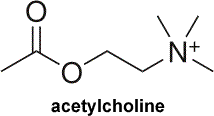
Alison Foster
Royal Botanic Gardens Kew
News from our Associates

Stuart Booker who has run the CHA office at Stoneleigh is moving on to pastures new and we wish hime well in his new job. The CHA will now be administered fom the Brasted office of the Federation of Garden & Leisure Manufacturers.
This October (26 - 27) CHA are launching GrowQuip, a major new international conference and exhibition for the commercial horticultural industry. To be held at the Stratford Manor Hotel, Stratford on Avon, GrowQuip will feature a one day conference followed by a trade exhibiton. On 27 October the trade exhibition will be open to all growers free of charge. For details of the conference, exhibitor packages and sponsorship opportunities visit the CHA website.
Horticulture Industry News
For the very latest horticultural news follow us on Facebook,
Twitter, or
LinkedIn
Controlling floating pennywort in a safe and sustainable way
CABI UK is collaborating with Argentinian and Brazilian institutes in an effort to identify the safest and most effective biocontrol agent for floating pennywort (Hydrocotyle ranunculoides) through comprehensive host range testing in CABI's UK quarantine facilities. The ultimate aim is to have a Pest Risk Analysis completed and be able to apply to Defra for its release in the UK. A damaging weevil (Listronotus elongatus) was prioritised for study, as well as a number of fungal species. Other agents under consideration, including a petiole mining fly species, will continue to be evaluated in Argentina in field studies to assess their preliminary suitability.
New crop varieties can't keep up with global warming
Crop yields around the world could fall within a decade unless action is taken to speed up the introduction of new varieties. A study says temperatures are rising faster than the development of crop varieties that can cope with a warmer world. In Africa, researchers found that it can take 10-30 years before farmers can grow a new breed of maize. By the time these new crops are planted, they face a warmer environment than they were developed in. In a meta-analysis scientists looked closely at the impact of temperature rises on crop duration - the length of time between planting and harvesting. They found that in a warmer world durations will be shorter meaning these varieties will have less time to accumulate biomass and yields could be affected. More
Rubber from Russian dandelions
Dutch researchers are working with international companies and research institutes to develop a European alternative source for rubber: natural rubber from the Russian dandelion Taraxacum koksaghyz. At the moment the world is totally reliant on Southeast Asia. In South America, where the first plantations were located, large-scale cultivation has become impossible due to a fungal disease. If the disease should spread to Asia the production of natural rubber would come to a halt. There needs to be an alternative. More
Watch out for the blue mint beetle
The blue mint beetle, Chrysolina coerulans, was detected breeding in the UK for the first time in July 2011. The foliage on mint plants in a garden at Newenden, Kent was being eaten by the adults and larvae of this insect. In September 2012 the beetle was confirmed as breeding in several locations in the vicinity of Ely, Cambridgeshire. The beetle is of widespread occurrence on the mainland of Europe and it may now spread and become a problem in the UK. The Royal Horticultural Society wants to hear from anyone who finds this beetle on their mint plants so the extent of the infestation can be assessed and its spread monitored. More
Varroa mites prefer nurses
New insights into the reproductive secrets of the Varroa mite has scientists edging closer to regulating them. The Varroa mite's lifecycle consists of two phases: one where they feed on adult bees, called the phoretic phase, and a reproductive phase that takes place within a sealed honeycomb cell, where the mites lay eggs on a developing bee larva. The latest study shows that the mites clearly prefer to infest adult bees at mid-age, or during the nurse phase of a bee's lifecycle when they take care of larvae, rather than during the younger (newly-emerged) or older (forager) phases of an adult bee. The study also found that the physiological type of a host bee had significant effects on the mite's reproductive fitness and success later on. The study clearly demonstrated that Varroa mites preferred nurses over the older and younger bees. Mites chose bees in the nurse phase of their lifecycle - the nutritional prime of bee life - over their older and younger counterparts at significantly higher rates. Also, those who fed on nurses had the highest reproductive success rates and the lowest infertility rates. More
Eating the hand that feeds you
A group of Australian researchers have shown that plants are able to consume whole bacteria and yeast cells. The term proposed for this newly discovered mode of nutrition is Rhizophagy. During the process of rhizophagy, microbes are corralled into protrusions of cell wall arising from root tissue. The cell wall closes off and traps the victims inside. The microbial cells are digested inside the plant cell, and the digested nutrients are transported through the plant and used for growth. This mind-blowing process was discovered by drenching tomato and mustard roots in a liquid solution that contained E. coli (a non-disease causing strain of course), and the common yeast S. cerevisiae. The microbes were labelled with a fluorescent dye enabling scientists to easily see them as bright glowing dots.
Events Calendar
Other Events of Interest:
Plum and Prune Genetics, Breeding and Pomology
17 - 21 Jul 2016, International Society of Horticultural Science
Freising-Weihenstephan, Germany
Molecular Plant-Microbe Interactions
17 - 21 Jul 2016, International Society for Plant Microbial Interactions
Portland, USA
Fruit Focus
20 Jul 2016, Haymarket Media
East Malling, UK
Genetics and Breeding of Cucurbitaceae
24 - 28 Jul 2016, Eucarpia
Warsaw, Poland
Colonization of the terrestrial environment
25 - 27 Jul 2016, New Phytologist Trust
Britol, UK
Woody Ornamentals of the Temperate Zone
2 - 5 Aug 2016, International Society of Horticultural Science
Mineapolis, USA
Phenotyping for photosynthesis and productivity
4 - 6 Aug 2016, University of Essex
Colchester, UK
Plants and BioEnergy
4 - 7 Aug 2016
Santa Fe, USA
Kew Science Festival
5 - 7 Aug 2016, RGB Kew
Kew, UK
Potato Research, Pathology and Pests
7 - 11 Aug 2016, James Hutton Institute
Dundee, UK
All Africa horticultural congress
7 - 12 Aug 2016,
Ibadan, Nigeria
Photosynthesis in a Changing World
7 - 12 Aug 2016, International Society of Photosynthesis Research
Maastricht, The Netherlands
Germplasm of Ornamental
8 - 12 Aug 2016, International Society of Horticultural Science
Atlanta, USA
International Strawberry Symposium
13 - 17 Aug 2016, International Society of Horticultural Science
Quebec, Canada
Seed Ecology
21 - 25 Aug 2016, International Society for Seed Science
Caete, Brazil
Integrating Canopy, Rootstockand Environmental Physiology in Orchard Systems
28 - 2 Sep 2016, International Society for Seed Science
Bologna, Italy
Moss
2 - 5 Sep 2016, University of Leeds
Leeds, UK
Plant Proteomics
4 - 7 Sep 2016, International Plant Proteomics Organization
Bratislava, Slovakia
Plants in action - coping with low oxygen
5 - 8 Sep 2016, International Society for Plant Anaerobiosis
Elsionor, Denmark
Innovation in the Plant Sciences
6 - 7 Sep 2016, Garnet
Cardiff, UK
Advances in Virology
7 - 9 Sep 2016, Association of Applied Biologists
Greenwich, UK
Seed, Transplant and Stand Establishment
11- 14 Sep 2016, International Society of Horticultural Science
Midrand, South Africa
Capsicum and Eggplant
12 - 14 Sep 2016, Eucarpia
Budapest, Hungary
Arabidopsis
14 - 16 Sep 2016,
Vienna, Austria
Models for plant growth, environment control and farming management in protected cultivation
19 - 20 Sep 2016, International Society of Horticultural Science
Avignon, France
Somatic Embryogenesis and Other Vegetative Propagation Technologies
19 - 23 Sep 2016, International Union of Forest Research Organization
La Plata, Argentina
Genomic Selection in plant breeding: from theory to practice
22 - 28 Sep 2016, ICARDA
Rabat, Morocco
Tropical and Subtropical Fruits
26 - 28 Sep 2016, International Society of Horticultural Science
Kafr El-Sheikh, Egypt
Cactus Pear and Cochineal
26 - 29 Sep 2016, International Society of Horticultural Science
Mendoza, Argentina
Genomic Selection in Crop Breeding
29 - 30 Sep 2016, ICARDA
Rabat, Morocco
Crucifer Genetics
3 - 6 Oct 2016
Melbourne, Australia
Chestnuts
3 - 7 Oct 2016
Antalya, Turkey
Botanic Gardens in South America
5 - 8 Oct 2016, BGCI
Cordoba, Argentina
Biology Week
8 - 16 Oct 2016, Royal Society of Biology
UK
Olive
10 - 14 Oct 2016, International Society of Horticultural Science
Split, Croatia
Apple
10 - 16 Oct 2016, International Society of Horticultural Science
Yangling, China
Biology Week: Parliamentary Reception
12 Oct 2106, Royal Society of Biology
London, UK
Persimmon
16 - 20 Oct 2016, International Society of Horticultural Science
Valencia, Spain
Horticulture in Europe
17 - 21 Oct 2016, International Society of Horticultural Science
Chania, Greece
Farming Futures
20 - 21 Oct 2016
Warwick, UK
Mineral Nutrition of Fruit Crops
24 - 29 Oct 2016, International Society of Horticultural Science
Antalya, Turkey
If you would like to advertise a forthcoming event please contact. ester.monfort@soci.org
Horticulture Group Contact Details
For submitting ideas or to volunteer to be part of a committee or a group, please contact:
Chairman - Tony Girard
Meetings Coordinator - Peter Grimbly
Minutes Secretary - Margaret Waddy
Newsletter co-ordinator - Sue Grimbly scihortigroup@btinternet.com
Group Contact - Julia Duckworth, E: julia.duckworth@soci.org T: +44(0)20 7598 1584
